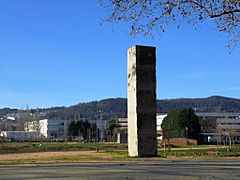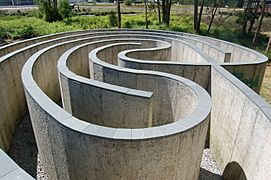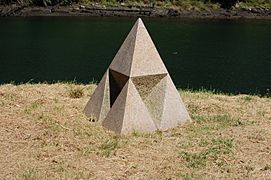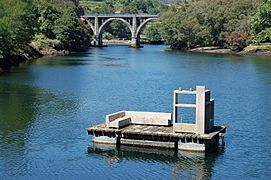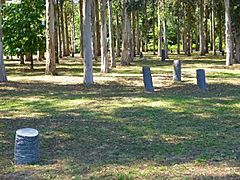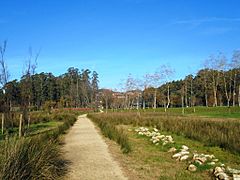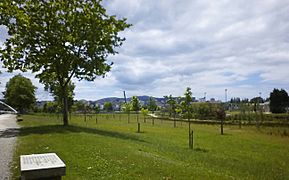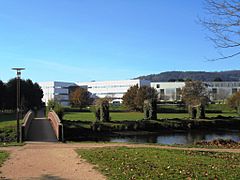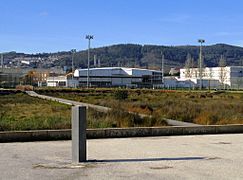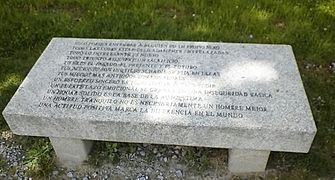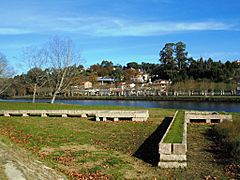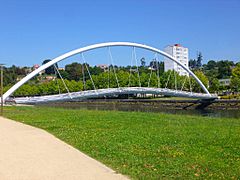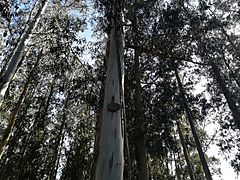Island of Sculptures facts for kids
Quick facts for kids Island of Sculptures |
|
|---|---|
| Illa das Esculturas Isla de las Esculturas |
|
 |
|
| Location | Pontevedra, Spain |
| Area | 7 ha (17 acres) |
| Created | 1997 (Park); 1999 (Sculptures) |
| Operated by | City Council of Pontevedra |
| Status | Public park |
The Island of Sculptures, also known as Illa das Esculturas in Galician, is a special park and island in Pontevedra, Spain. It's located close to where the Lérez River meets the sea. This island is about 70,000 square meters, which is like 10 football fields!
What makes it so cool? It's home to twelve amazing sculptures made from granite by artists from all over the world. It's the biggest outdoor art show that stays open all the time in Galicia. It's also one of the most important in all of Spain.
On the island, you can find a tall labyrinth by Robert Morris. There's also a huge pink granite stone, called a menhir, by Ulrich Rückriem. You might even spot a floating house on the river by Francisco Leiro! Bridges connect the island to both sides of the river, making it easy to visit. You can also see ducks and fish like carp in the water around the island.
Contents
How the Island Was Formed
This island wasn't always here! It started forming in the river from tiny bits of sand and dirt. The Lérez River carried these sediments along. But as the river got closer to the sea, it slowed down. It lost the strength to carry the sediments away.
So, these sediments piled up and created a flat area. The river then had to find a new path around this obstacle. This is how it opened a new channel on the right side, creating the island we see today.
A Park for Art and Nature
For a long time, the island was just wild land. But in 1997, it was turned into a park. Then, something even more exciting happened! A plan was made to fill the park with modern art.
Twelve famous international artists were invited to create sculptures. Their main ideas were using Galician granite and showing how people connect with nature. This project is a great example of land art in Galicia. Land art is a type of art where the landscape itself is part of the artwork. The Island of Sculptures officially opened on July 29, 1999.
Exploring the Island
The Island of Sculptures is a protected natural area. It's almost a kilometer long and has a long, narrow shape. You'll find areas with tall rushes, open meadows, and paths to explore.
Three wooden bridges cross a small inner canal. A cool cable-stayed footbridge goes over the Lérez River. This bridge connects the island to the Lérez Promenade. The island is also a home for many birds, especially for breeding. The tides come in and out around the island. It's a special protected area called a "place of community interest" (LIC). Many people from the nearby Pontevedra Campus also use the island for walks or sports.
Amazing Sculptures to Discover
Here are some of the incredible sculptures you can find on the island, created by artists from around the world:
- Giovanni Anselmo (Italy): His work is called Cielo acortado (Shortened Sky). It's a black granite column, about 1.2 meters tall. It represents the space between the sky and the earth.
- Ulrich Rückriem (Germany): He created a pink granite Column. This tall stone, about 5 meters high, reminds people of old Galician traditions.
- Robert Morris (USA): He made the Labyrinth of Pontevedra. This circular labyrinth is 2 meters high and has a black slate roof. It's inspired by the oldest petroglyph (rock carving) in Europe, found in Marín.
- José Pedro Croft (Portugal): His House is built from grey granite. It's 3.2 meters tall and has no doors or windows. A tree grows right through its walls, showing how nature and human creations can blend.
- Jenny Holzer (USA): She placed Eight grey stone benches along the main path. Each bench has twelve thoughtful phrases or aphorisms carved into it. These benches make art useful for everyday life.
- Richard Long (England): His piece is called Pontevedra Line. It's a small wall, 37 meters long, made from white granite pieces. It makes you think about walking as a way to explore and think.
- Ian Hamilton Finlay (Scotland): He created Three green slate medallions. These are hanging from eucalyptus trees. Each medallion has "Petrarch" and Roman numerals carved into it, referring to sonnets (poems). They invite you to discover hidden meanings.
- Anne and Patrick Poirier (France): Their work is Folie. It's a 3,000 square meter garden located outside the island, meant to be viewed from it. It uses stainless steel, grey granite, plants, and trees.
- Dan Graham (USA): He made a Pyramid from pink granite. It's 1.9 meters high and seems to double in the river's water. It has three carved inverted pyramids inside. The polished granite and its placement near the water create cool light effects.
The Spanish artists and their works are:
- Fernando Casás represents The 36 righteous from Hebrew tradition. He uses thirty-six black granite blocks, which look like tree trunks in a forest.
- Francisco Leiro created Saavedra. This is a living room set up on a raft floating in the Lérez River. People often call it La Batea. It makes a familiar space feel far away and unusual.
- Enrique Velasco made a double Camino de Juncos (Reed Path) on the river bank. This shows how flexible and bendable granite can be, even though it's a hard stone.
Gallery
-
Labyrinth of Pontevedra, by Robert Morris
-
Pontevedra Line by Richard Long.
-
Granite benches by Jenny Holzer
-
Bench by Jenny Holzer
-
Pedestrian footbridge over the Lérez river
See also
 In Spanish: Isla de las Esculturas para niños
In Spanish: Isla de las Esculturas para niños
- Land art
- Paseo Marítimo de Pontevedra



